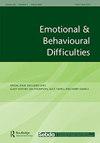什么是社会能力?反社会行为儿童观念的调查
IF 1.5
Q3 PSYCHOLOGY, EDUCATIONAL
引用次数: 5
摘要
摘要本研究通过三个不同的测量水平(总体水平、因素水平和项目水平)调查了儿童的社会能力,在父母和儿童的样本中参与了对出现或存在的儿童问题行为的干预。550名3-12岁儿童(71%为男孩)的父母使用家庭和社区社会行为量表(HCSBS)评估社会能力,该量表评估两个方面的概念:同伴关系和自我管理/依从性。在所有32个项目中添加了一个指数来检查父母如何报告不同年龄的整体社会能力,而因子分析用于调查他们潜在的结构。运用网络分析的方法,探讨社会能力项目之间的联系和相互作用。结果显示,父母认为女孩的整体社交能力高于男孩,但这种差异在12岁左右就消失了。因子分析结果表明,双因子- esem模型拟合效果最佳,而网络分析结果则显示了项目的差异聚类和强度中心性。讨论了这些结果的意义。本文章由计算机程序翻译,如有差异,请以英文原文为准。
What is social competence? An investigation into the concept among children with antisocial behaviours
ABSTRACT The study investigates child social competence a three different measurement levels (overall level, factor level, and item level), in a sample of parents and children participating in interventions towards emerging or present child problem behaviours. Parents of 550 children aged 3–12 (71% boys) evaluated social competence using the Home and Community Social Behaviour Scales (HCSBS), which assess two aspects of the concept: peer relations and self-management/compliance. An additive index across all 32 items was made to examine how parents reported overall social competence across ages, whereas factor analysis was used to investigate their underlying latent structure. Network analysis was used to investigate how the social competence items connect and interact. Results showed that parents reported higher levels of overall social competence among the girls compared to the boys, but this difference vanished about age 12. Factor analyses showed that a bifactor-ESEM model obtained the best model fit to data, whereas the network analysis revealed differential clustering and strength centrality for the items. Implications of these results are discussed.
求助全文
通过发布文献求助,成功后即可免费获取论文全文。
去求助
来源期刊

EMOTIONAL AND BEHAVIOURAL DIFFICULTIES
PSYCHOLOGY, EDUCATIONAL-
CiteScore
1.80
自引率
10.00%
发文量
10
期刊介绍:
The central intention of Emotional & Behavioural Difficulties (EBDs) is to contribute to readers" understanding of social, emotional and behavioural difficulties, and also their knowledge of appropriate ways of preventing and responding to EBDs, in terms of intervention and policy. The journal aims to cater for a wide audience, in response to the diverse nature of the professionals who work with and for children with EBDs.
 求助内容:
求助内容: 应助结果提醒方式:
应助结果提醒方式:


